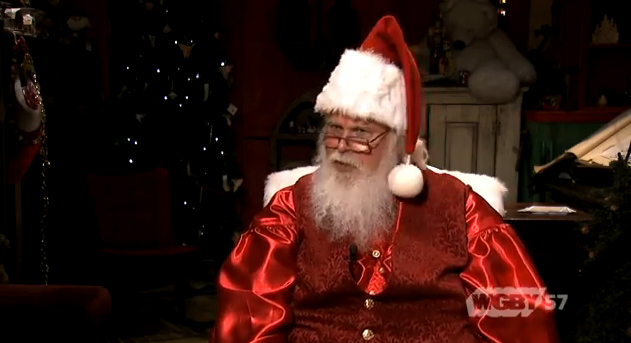My friend Al told me he was struggling with telling his four-year-old daughter about Santa Claus. “It’s the only lie I’ve ever told her,” he said. I too have a four-year-old daughter and am currently in the thick of Santa Fever at my house, where we’ve been lauding Père Noël for the last three Christmases. He’s a legend I’m honored to propagate. I study legends for a living. Monsters, ghosts, extraterrestrials, and ancient mysteries swirl around me like smoke from a smoldering campfire. If there’s one thing that’s certain: it’s that all legends have a solid foundation in someone’s reality. From there the story grows and evolves; it becomes part of a collective human experience. Legends are real. The point can’t be argued. When I say “Bigfoot,” an image is instantly conjured in your mind. You no doubt picture a tall, hairy, upright-walking creature who lurks in the forest. There are Halloween costumes that feature this biped, he even shills beef jerky in TV commercials. Can there be any doubt as to the veracity of this legend? Whether there is an actual ape-like creature wandering the forests of America can be debated forever. But the legend itself cannot. Belief makes reality. The only reason that $20 bill in your pocket is worth more than the $1 bill is belief. Faith. We believe our government will back up these bank notes so they’re worth something. If we collectively lose that belief, our monetary system will collapse. Of all the legends in America, there can be none as prominent, or as real, as that of St. Nick. If I were to walk into a crowded restaurant anywhere in the United States holding an image of a big man with white hair and a white beard wearing a red suit and asked each diner, “Who is this?” I would have trouble finding a single person who wouldn’t answer, “Santa Claus.” Before there was the hoopla, the guy in the red suit at the mall, the shopping frenzy, the Christmas trees, and the holiday lights, there was a man—a regular man who was the foundation of something extraordinary. Nicholas lived in the land of Myra (which is modern-day Turkey) around 300 A.D. He was the only child of a wealthy family and was orphaned at a young age. The boy grew up in a monastery and entered priesthood by age 17. A true philanthropist, and inspired by a person named Jesus who lived long ago, Nicholas gave away his wealth throughout his life. He left gifts for children in their shoes, he was known to toss small sacks of gold through open windows, and to lavish affection upon the poor. The Catholic Church canonized him shortly after his death, making him St. Nicholas. A real person inspired Catholics to make him into a saint. When the Church established Christmas on December 25th to coincide near the Pagan holiday of Yule, incorporating Nicholas and his spirit of generosity into the Christmas season was a natural fit for the Church. The legend of that saint grew, evolved, and spread through a natural folklore process. Over the centuries, Nicholas’s story was passed around, he was copy-catted by others who took joy in giving away money and toys to poor children. As the centuries passed, his legend grew to mythic proportions and took on supernatural attributes. The Dutch people called this figure “Sinter Klaas,” and brought him over to New York when they arrived in the seventeenth century. They celebrated this saint on December 5th or 6th (depending on what country you lived in). Washington Irving wrote about this figure in his History of New York where he described the arrival of the Saint on horseback, but it was a poem penned by Clement Clarke Moore in 1823 that defined Santa Claus, his sled, the reindeer, what he looks like, and his chimney-arrival behavior. That poem is called “A Visit from St. Nicholas,” better known as “The Night Before Christmas.” In 1860 a Harper’s magazine illustrator named Thomas Nast depicted Santa as a big round man who had a workshop at the North Pole and a list of all the good and bad children. In 1931 the Coca Cola Company made the figure of Santa in a red suit with white fur trim a cultural icon as part of their advertising campaign. The first time a child meets Santa Claus, it’s like meeting the world’s biggest celebrity. Most of us never forget the racing heartbeats, the giddy excitement, or maybe even the fear of meeting this omniscient, supernatural being who can either make your dreams come true by laying your most desired toy under the Christmas tree, or crush you with lumps of coal and sticks in your stocking. As we get older, our ideas of Santa morph and evolve until many of us actually become Father Christmas—either at the office holiday party or when we have children of our own. The Santa experience offers genuine miracles on both sides of the fluffy white beard in a world where most mysteries are dying off at an alarming rate. Since Santa went mainstream in the nineteenth century, he’s has been deified, lampooned, imitated, commercialized, scorned, and overexposed. But through all the murk and mess, Santa’s magic still shines through like Rudolph’s nose through the fiercest blizzard. We created Santa. All of us. Each Christmas he’s born again. We teach our own children about Santa because, even if only for the first few years, it’s right to believe in magic. From the children’s perspective, it’s so wonderfully simple: On December 24th, before they go to bed they leave milk and cookies out for Santa. They glance at the empty space under the Christmas tree, and run off to try and sleep; giddy with anticipation. The next morning there is tangible evidence of the supernatural visitation: The cookies are mostly eaten, the milk is mostly drunk, and behold the wrapped presents under the tree! I don’t care if you’re Christian


